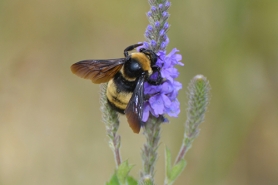Saving Wisconsin's Native Pollinators
Many pollinators, such as bees, butterflies and moths, are in decline, and their losses threaten Wisconsin wildflowers, ecosystems, crops and natural areas that depend upon them. Pollinators transfer pollen, which then helps plants produce fruits and seeds. Many native plants, as well as many food crops, rely on pollinators.
Threats
The main threats facing pollinators, in general, are habitat loss, degradation and fragmentation. As native vegetation is replaced by roadways, manicured lawns, crops and non-native gardens, pollinators lose the food and nesting sites necessary for survival. Migratory pollinators, such as monarchs, face unique challenges. As the distance between the suitable habitat patches and their migration route increases, more individuals may die during their journey.
Frequently Asked Questions
Where can I learn more about Wisconsin's pollinators?
Explore the Wisconsin DNR's rare butterfly, moth and bee species pages, which contain information on where they are found in the state, their level of legal protection and photos. Life history and management considerations are available for many species, and new information is continually being added.
For more information about our pollinators, here are a few additional resources.
- Bully for bees [PDF]
- Learn more with monarch webinars [exit DNR]
- What you can do to help the monarch [PDF]
- Bees of Wisconsin (Wolf & Ascher 2008) [PDF]
- Xerces Society for Invertebrate Conservation [exit DNR]
- Pollinator Partnership [exit DNR]
- Become a supporter of the Wisconsin Monarch Collaborative [exit DNR]
- UW Extension's Pollinators
- Read about some of our accomplishments in protecting pollinators
What are Wisconsin's pollinators?
In Wisconsin, most pollinators are insects like bees, butterflies and moths. Wisconsin's pollinators also include hummingbirds and some beetles and flies. The species of bats found in Wisconsin are not pollinators.
Wisconsin is home to many pollinators that are rare and in decline, including several state and federally-protected species and other species of concern:- Bees — Rusty Patched Bumble Bee, Yellowbanded Bumble Bee
- Butterflies — Swamp Metalmark, Monarch, Ottoe Skipper, Northern Blue, Karner Blue, Poweshiek Skipperling, Regal Fritillary
- Moths — Silphium Borer Moth, Phlox Moth
How can I create homes and habitats for pollinators?
There are many DNR and non-DNR online resources with recommendations on how to create homes and habitats. The best choice is to plant native plants.
Where to Get Native Plants and Seeds
Planting Guides
- DNR's Simple Steps to Help Pollinators
- Native Plants for Beginners [PDF]
- Plant for monarchs [PDF]
- The Field Museum's Urban Monarch Conservation [exit DNR]
- Xerces' Pollinator Plants Great Lakes Guide [exit DNR]
- Xerces' Pollinator Meadow Installation Guide and Checklist [exit DNR]
- Pollinator Partnership's Eco-Regional Planting Guides [exit DNR]
- DNR's Native Plant Recommendations for Landscaping [PDF]
- Wisconsin School Garden Initiative
Give water and shelter: Pollinators need water to drink and safe places to rest, avoid bad weather and spend the winter. You can provide brush and leaf piles, create bee nest boxes, leave patches of bare earth and provide water, such as a bird bath.
What funding is available to create pollinator habitats?
If you own land in Wisconsin's Driftless Area, the DNR's Landowner Incentive Program can provide technical assistance to landowners to create and restore habitats for pollinators. The DNR also administers many other grant and loan programs.
What opportunities exist to volunteer with the DNR or get involved with citizen science related to pollinators?
For many of our pollinators, there is a lack of data on population status and trends. Please help fill that knowledge gap and learn more about citizen science with the Wisconsin Citizen-based Monitoring Network [exit DNR] or become involved in a citizen science project:
- Bumble bee projects — Wisconsin Bumble Bee Brigade [exit DNR]
- Monarch projects — The Monarch Larva Monitoring Project [exit DNR], eButterfly (iNaturalist) [exit DNR] or Journey North [exit DNR].
Become a Wisconsin State Natural Areas volunteer
Become a volunteer for the Wisconsin rare plant monitoring program [exit DNR]
How can I identify my photo of an insect?
- Submit your photo and observation record to iNaturalist [exit DNR] or BugGuide [exit DNR] for crowd-sourced identification.
- Send an insect collected in Wisconsin or email a photo to the UW Insect Diagnostic Lab [exit DNR].
Where should I report an observation of an insect?
For many of our pollinators, there is a lack of data on population status or trends. Please help fill that knowledge gap and report your observations:
- Bumblebee observations — Wisconsin Bumble Bee Brigade [exit DNR]
- Monarch observations — The Monarch Larva Monitoring Project [exit DNR], eButterfly (iNaturalist) [exit DNR], or Journey North [exit DNR].
- Other butterfly and moth observations are as follows: Wisconsin Natural Heritage Inventory [exit DNR], eButterfly (iNaturalist) [exit DNR], or Butterflies and Moths of North America [exit DNR].
What are other Wisconsin pollinator projects that I can join?
- Join the Karner Blue Volunteer Monitoring Program [exit DNR]
- Connect with the Wisconsin Monarch Collaborative [exit DNR]
- Support and implement conservation strategies in the Wisconsin Pollinator Plan (DATCP) [exit DNR]
- Become a volunteer for the Wisconsin rare plant monitoring program [exit DNR]
- Sign-up for a field trip with Wisconsin's Natural Resources Foundation [exit DNR]
- Attend a Wisconsin citizen-based monitoring event [exit DNR]
- Become a Wisconsin Master Naturalist [exit DNR] or Master Gardener [exit DNR]
- Register your pollinator garden on the Million Pollinator Garden Challenge [exit DNR]
- Participate in a Southern Wisconsin [exit DNR] Butterfly Association butterfly count or field trip
- Join a Monarch Joint Venture [exit DNR] monitoring, education, research or conservation project.
- Become a Wisconsin State Natural Areas volunteer

